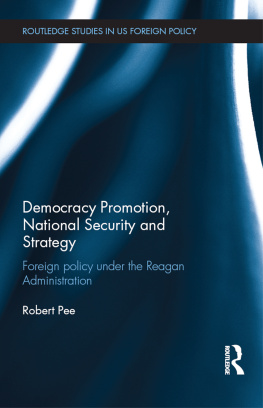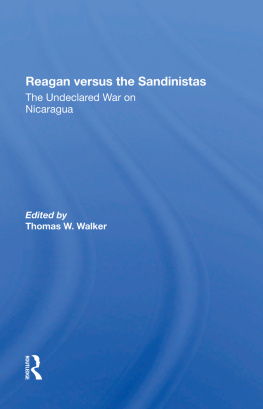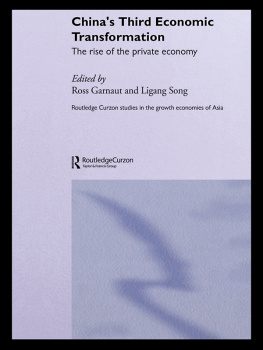REVOLUTION
Volume 21
THE POLITICAL ECONOMY OF REVOLUTIONARY NICARAGUA
First published in 1987 by Allen & Unwin, Inc.
This edition first published in 2022
by Routledge
4 Park Square, Milton Park, Abingdon, Oxon OX14 4RN
and by Routledge
605 Third Avenue, New York, NY 10158
Routledge is an imprint of the Taylor & Francis Group, an informa business
1987 Allen & Unwin, Inc.
All rights reserved. No part of this book may be reprinted or reproduced or utilised in any form or by any electronic, mechanical, or other means, now known or hereafter invented, including photocopying and recording, or in any information storage or retrieval system, without permission in writing from the publishers.
Trademark notice: Product or corporate names may be trademarks or registered trademarks, and are used only for identification and explanation without intent to infringe.
British Library Cataloguing in Publication Data
A catalogue record for this book is available from the British Library
ISBN: 978-1-032-12623-4 (Set)
ISBN: 978-1-003-26095-0 (Set) (ebk)
ISBN: 978-1-032-12843-6 (Volume 21) (hbk)
ISBN: 978-1-032-12844-3 (Volume 21) (pbk)
ISBN: 978-1-003-22643-7 (Volume 21) (ebk)
DOI: 10.4324/9781003226437
Publishers Note
The publisher has gone to great lengths to ensure the quality of this reprint but points out that some imperfections in the original copies may be apparent.
Disclaimer
The publisher has made every effort to trace copyright holders and would welcome correspondence from those they have been unable to trace.
Cover/jacket photo by William Denton.
Cover/jacket design by Jean Morley.
Copyright 1987 by Allen & Unwin, Inc.
All rights reserved.
Allen & Unwin, Inc.
8 Winchester Place, Winchester, MA 01890, USA
George Allen & Unwin (Publishers), Ltd
40 Museum Street, London, WC1A 1LU, UK
George Allen & Unwin (Publishers), Ltd
Park Lane, Hemel Hempstead, Herts HP2 4TE, UK
George Allen & Unwin Australia Pty Ltd
8 Napier Street, North Sydney, NSW 2060, Australia
First Published in 1987
Library of Congress Cataloging-in-Publication Data
The Political economy of revolutionary Nicaragua.
(Thematic studies in Latin America)
Bibliography: p.
Includes index.
1. NicaraguaEconomic policy. 2. NicaraguaEconomic conditions1979 I. Spalding, Rose J.
HC146.P65 1986 338.97285 86-14095
ISBN 0-04-497014-5 (alk. paper)
ISBN 0-04-497015-3 (alk. paper : pbk.)
British Library Cataloguing in Publication Data
Political economy of revolutionary Nicaragua.
1. NicaraguaEconomic Conditions 1979. 2. NicaraguaPolitics and government1979
I. Spalding, Rose J.
330.97285053 HC146
ISBN 0-04-497014-5
ISBN 0-04-497015-3 Pbk
MANUFACTURED IN THE UNITED STATES OF AMERICA
PART I OVERVIEW OF THE NEW ECONOMIC MODEL
Chapter 1
A Structural Overview of The Nicaraguan Economy
BILL GIBSON
When a column of 1000 Sandinista troops marched victoriously into Managua on July 19, 1979, it seemed to all that this small Central American nation was on the brink of an historic transformation. The 34-year dictatorship of the Somoza family was at last broken, and the hated National Guard was disbanded. The very conception of what Nicaragua wasa banana republic"1 subservient to U.S. political and economic interestswas shattered. Gone was Somozas crony capitalism" that had served to enrich his friends and associates while impoverishing the large majority of the people. It was now within the power of the architects of the Sandinista revolution to change the basic structures of the society. Three principles illuminated the path forward: popular participation, political nonalignment, and a mixed economy.
Now 7 years after the insurrection, the euphoria of victory has given way to the labor of reconstruction and renewed struggle for self-determination. The Sandinistas have found it much easier to make a revolution than to manage a war economy, especially at time in which the prices of Nicaraguas principal exports have collapsed and a third of export earnings goes to service the foreign debt.2 The fear is that the revolution will stumble under the weight of external pressure and the Sandinistas will renege on their promise to erect a just, equitable, and democratic society. In the years since the revolution, the Sandinistas have clearly tested the limits of the possible within the framework defined by their three guiding principles. Although it is true that Nicaragua has undergone a profound transformation, there are many basic features of the economy that the Sandinistas are powerless to change. Nicaragua remains a poor, underdeveloped country in which policymakers struggle with many of the same dilemmas of economic development which plagued their predecessors.
1. Nicaragua was never literally a banana republic. A combination of bad weather, labor unrest, and disease forced foreign banana plantation owners to abandon their operations until after World War II. Since then, banana export earnings have been only about 1 -2% of the total. The term is nevertheless appropriate for its political connotation.
2. For more details, see the chapter in this collection by Stahler-Sholk.
This chapter is concerned with questions of basic economic structure and how it has evolved under the leadership of the Frente Sandinista. The chapter provides an overview of the changing structure, problems, and policies of the Nicaraguan economy, beginning with the Somocista period. The following section focuses on the nature of the agroexport model, how it was managed under Somoza, and the impact of the model on the people of Nicaragua. By diverting resources to a small class of wealthy landowners (which included the family itself), the Somoza dictatorship intensified the social contradictions that ultimately led to the insurrection of 1979. The third section broadly outlines the nature of the structural change brought about by the Sandinistas. It is argued that the secret of the relative autonomy enjoyed since the revolution lies in the Sandinistas ability to control Nicaraguas participation in the world economy. Through the nationalization of the banking system and foreign trade, Nicaragua has so far escaped the grip of the international financial system. The conclusion of the chapter argues that it is ironically the successes of the Sandinistas that pose the ultimate threat to their existence. Indeed, whether Nicaraguans remain in control of their country now largely depends on the international reaction to the Sandinistas challenge to the traditional means of North-South domination.
The Somoza Era: Comparative Advantage and Passive Macropolicy
A Conceptual Model
It is appropriate to conceptualize the Nicaraguan economy in three broad sectorsagriculture, manufacturing, and commercethough special caveats apply to each. Agriculture is the engine of growth of the economy in that it is responsible for the lions share of vital export earnings. This sector consists of a modern, capital-intensive agroexport subsector and a backward, traditional domestic subsector that produces basic wage goods. The agroexport sector depends upon imported intermediate and capital goods and absorbs a disproportionate share of domestic resources, with the exception of labor. Traditionally, export agriculture has been technically advanced; productivity in the food sector, on the other hand, has been by and large at a standstill. Because of productivity differences, total agricultural supply depends not only upon the quantity of land brought under cultivation but also on the mix between the export and domestic market crops. Value added is also influenced by the degree to which agricultural raw materials are processed. The degree of processing increases as the economy matures.







